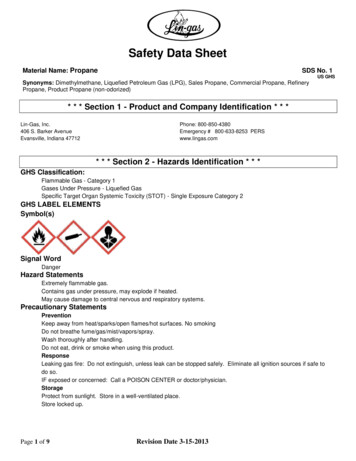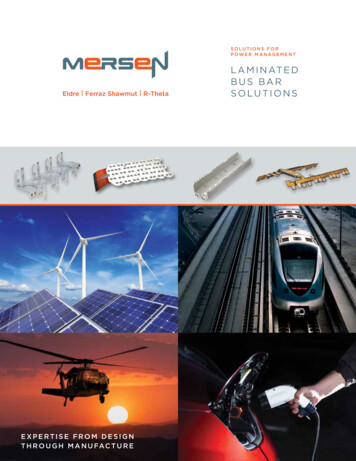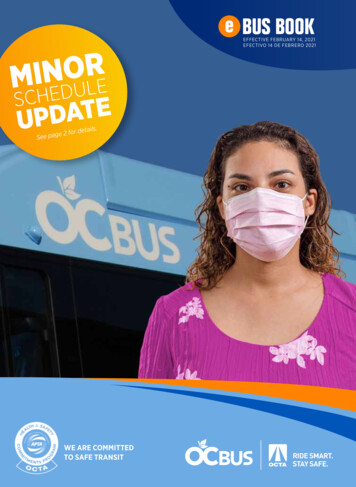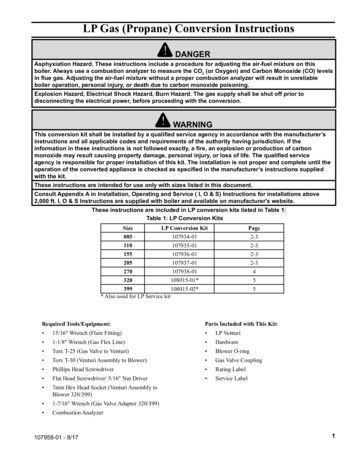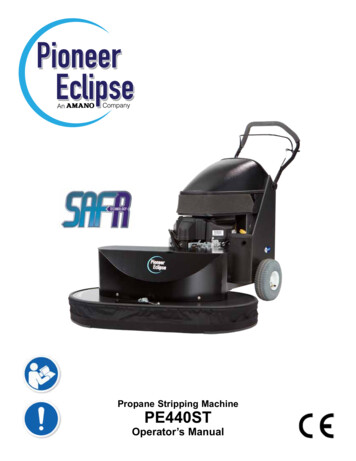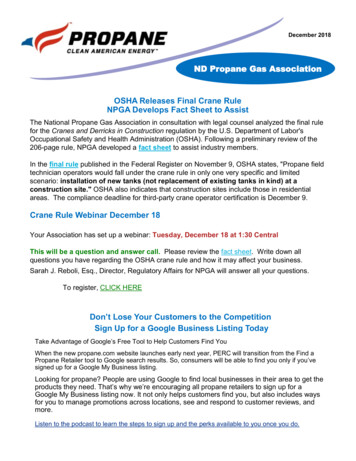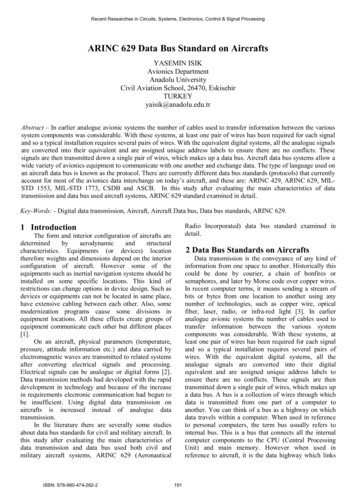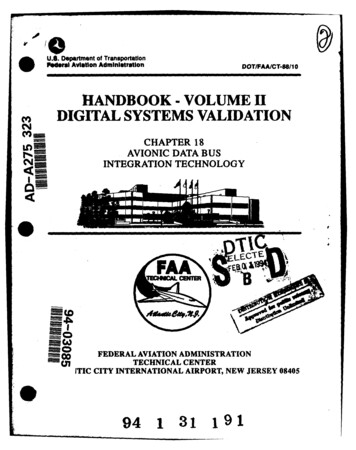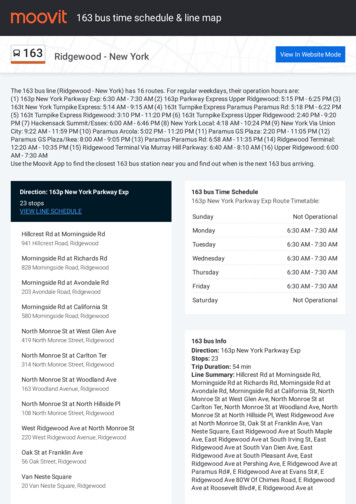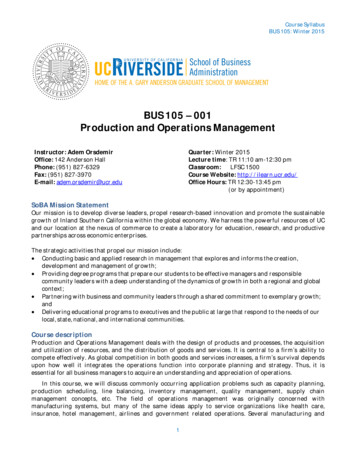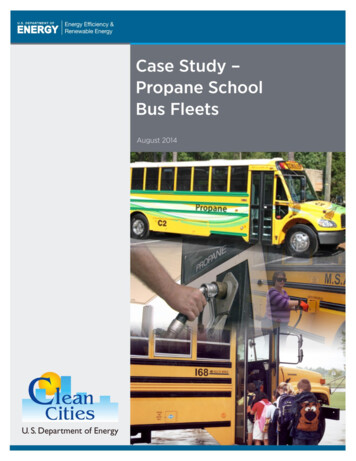
Transcription
ContentsBackground . 3Motivation for Adopting Propane . 4Financial Benefits . 4Environmental and Energy Benefits . 6Project-Specific Activities . 7Vehicles Deployed. 7Infrastructure Deployed . 7Training for Drivers and Technicians . 7Data Analysis Results . 8Summary of Vehicle Operational Data. 8Environmental and Energy Impact Data . 9Business Case Data . 9Lessons Learned and Future Plans . 12Alvin ISD . 12Dallas County Schools. 12Northside ISD . 13Ysleta ISD. 13Gloucester County Schools . 13General Observations . 13Conclusion . 14Supplemental Information. 151
2
Case Study – Propane School Bus FleetsBackgroundPropane is a promising alternative fuel for schoolbuses because it is widely available, even in ruralareas, and it can cost less than diesel or gasoline.Propane is generically known as liquefiedpetroleum gas (LPG), and is sometimes marketedas propane “autogas” when used for vehicleapplications. This case study highlights five schooldistricts that used propane-fueled school busessuccessfully. Four of the districts are in Texas:Alvin Independent School District, Dallas County Schools,Northside Independent School District; and YsletaIndependent School District. The fifth district, GloucesterCounty Schools, is in Virginia. This case studycompiles information from these five Texas andVirginia school districts and broadly discusses theirexperiences, lessons learned, and considerations fordeployment in other fleets.MAJOR FINDINGS Cost Savings – Some of the school districts inthis study save nearly 50% on a cost per milebasis for fuel and maintenance relative to diesel. Payback Period – The incremental cost of thepropane buses and fueling infrastructure can berecouped in 3–8 years. Improved Efficiency – The newest propaneengine technologies are more efficient thanolder technologies still in use. Typical Usage – Propane buses in this casestudy traveled around 14,700 miles per year onaverage and achieved fuel economy of 7.2 milesper diesel gallon equivalent (DGE). Energy & Environmental Impact – The totalThe Texas fleets were funded in part by Federalpetroleum displacement was 212,000 DGE pergrants under the American Recovery andyear for these 110 buses, while greenhouse gasReinvestment Act (Recovery Act) of 2009. The(GHG) reductions were approximately 770 tonsDepartment of Energy’s Vehicle Technologiesper year.Office received almost 300 million in RecoveryAct funding to support 25 Clean Cities projects to reduce petroleum consumption and emissions through thedeployment of alternative fuel and advanced technology vehicles and fueling stations across the United States.These buses were deployed as part of the Texas Propane Fleet Pilot Program, a 45.2 million Recovery Actproject run by the Railroad Commission of Texas that included more than 600 propane vehicles and30 propane fueling stations. Similarly, the Virginia fleet received funding as part of the Clean School Bus USAMiddle Peninsula Project, a U.S. Environmental Protection Agency (EPA)/Virginia Department ofEnvironmental Quality program. The Mid-Atlantic Regional Air Management Association also supported thepurchase of the propane school buses with a leveraged funding contribution.Propane has been used as an alternative fuel in school bus applications for many years, particularly in areas ofthe country with relatively low-cost propane. In the early 2000s, the only original equipment manufacturer(OEM) propane vehicle available in the school bus market was discontinued because production ceased forthe engine and chassis upon which it was based, and suitable replacements were not immediately available. Asa result, school bus fleets were unable to maintain or expand their propane bus purchases. The recentintroduction of new school bus product lines with improved engine technologies has revitalized interest inpropane as a low-cost option for school bus fleets. These new buses incorporate more advanced fuelinjection systems that are more efficient and more reliable than their predecessors. The new generation ofbuses was first introduced in 2008 and was quickly adopted by several school bus fleets, as described below.3
Figure 1.In Texas, Alvin Independent School District (ISD) is locatedAlvin ISDin the Houston area (northern Brazoria County). Itpropaneschool busbegan purchasing propane buses in 1980. Dallas Countyand busSchools is an intermediate educational agency in thedepot. AlvinISD.Dallas metropolitan area that serves the 14 independentschool districts in Dallas County. The Dallas CountyFigure 2.GloucesterSchools bus fleet is one of the largest in the nation andCountyis the largest propane school bus fleet in Texas.officials withBluebirdNorthside ISD serves a portion of the San AntonioVisionmetropolitan area and has the second-largest propanepropane bus.Virginia Cleanschool bus fleet in Texas. At one point, the majorityCities.of the Northside ISD bus fleet was propane-powered(garnering it a Clean Cities National Partner Award in2001). However, the lack of propane school busproducts caused Northside to purchase conventional school bus technologies for a number of years. NorthsideISD maintained its interest in propane during this time, and it was the first school district in the nation topurchase the Blue Bird Vision propane bus when it was made available in 2008. The Blue Bird Vision busengine uses a newly developed liquid propane injection (LPI) system that improves engine performancerelative to previous propane technologies. Ysleta ISD serves a portion of the El Paso metropolitan area andhad not operated any propane buses prior to receiving Recovery Act funding.In Virginia, Gloucester County Schools serves the Hampton Roads area (Williamsburg/Newport News). It wasthe first school district in the state to implement propane in its school bus fleet. Table 1 summarizes themajor characteristics of each school district, including the total number of propane buses and fueling stations.Table 1. Basic Characteristics of School Districts in Case Study.Area Served(squaremiles)StudentsServedTotal BusFleetPropane BusFleetYearly FleetMilesTraveled(millions)Yearly FleetFuel Use(thousandsof gallons)Year FleetFirst UsedPropaneNumber ofOnsitePropaneStationsAlvin (TX)25018,200192112250019801Dallas (TX)908425,0001,597560202,70019947Northside (TX)355100,00083135591,70019805Ysleta (TX)6044,00020030230020101Gloucester (VA)2005,500905124020091School DistrictMotivation for Adopting PropaneAll of the school districts chose propane for financial reasons. Fleets are able to secure advantageous fuelprices for propane to achieve significant operating cost savings. These districts also mentioned theimportance of emission reductions with propane, but emission reductions were secondary to cost reductionsas a motivator.Financial BenefitsAs will be described in more detail later in this case study, these fleets have seen financial benefits as a resultof using propane buses. These fleets have saved between 400 and 3,000 per propane bus per year, with therange of savings dependent on the fuel prices and the maintenance cost savings realized. Maintenance cost4
savings for propane engines can potentially come from several areas, including less-frequent oil changes andless-complicated emission control systems that do not use diesel exhaust fluid.Alvin ISD representatives noted the low fuel cost andlower maintenance costs as considerations for its propaneschool bus use. The school district estimated its annualfuel cost savings with propane to be about 330,000, orjust under 3,000 per propane bus per year. Alvin ISDnoted that the maintenance costs for the propane buseswere lower overall than for the diesel buses. In anexamination of its vehicle maintenance data for Januarythrough December 2010, Alvin ISD found thatmaintenance costs of its 2010 propane buses weresignificantly lower than its 2006 diesel buses, as shown inFigure 3. This can partially be attributed to the ageFigure 3. Maintenance costs per mile for Alvin propanediscrepancy between the buses, but it can also beand diesel buses.attributed to the lower maintenance requirements for thepropane buses. Alvin ISD is seeing extended oil change intervals of 10,000 miles for the propane buses,relative to the 6,000–7,000-mile interval for the diesel buses. Anecdotally, Alvin ISD observed lower tire wearon the front steer axle and noted that the lower weight of the propane engine might make this anotherpotential area for maintenance cost savings.Dallas County Schools noted the fuel cost savings available to fleets using propane school buses, observing ahistorical price differential of 30% for propane relative to gasoline. The school district estimated it is savingabout 1.5 million in fuel costs annually through the use of propane, or just under 3,000 per propane bus peryear. Its transportation director, Tim Jones, stated, “The OEM LPG bus and new retrofit LPG systems arevery exciting for DCS to renew our LPG lower emission fleet.”Northside ISD is also seeing financial benefits from its propane use, estimating an annual fuel cost savings ofabout 320,000. This translates to a savings of just under 1,000 per propane bus per year. Northside ISD alsonoted that propane use has significantly reduced its maintenance costs. One maintenance cost reduction isrelated to oil change intervals: using oil analysis, Northside ISD has been able to lengthen the oil changeintervals for its propane buses.Ysleta ISD’s Transportation Supervisor, Frances Yepez, indicated that the school district is interested in usingpropane for its environmental benefits, as well as its financial benefits. The district is still developing aninternal financial analysis to assess the financial benefits.Gloucester County Schools began investigating propane in 2008 as petroleum fuel prices increased rapidly. “We’vebeen looking for ways to save money,” stated Roger Kelly, Director of Transportation for Gloucester CountySchools. When the five propane buses in this study were compared with five diesel buses of similar vintage inthe school district’s fleet for the first year of the propane bus operations, Gloucester calculated a savings ofover 2,000 for fuel and maintenance costs, or around 400 per propane bus per year. In a sample ofmaintenance data Gloucester collected between October 2009 and December 2010, the school district foundthat it was saving roughly 6 cents per mile in maintenance costs. In this case, the Gloucester diesel buses were2009 models and its propane buses were 2010 models; this made for a reasonable comparison of maintenance5
costs for buses of similar age but differing technology, asFigure 4 shows. Less-frequent oil changes were amongthe maintenance cost benefits Gloucester observed.Environmental and Energy BenefitsThe use of propane in vehicle applications can reduceGHG emissions while also reducing dependence onpetroleum. The Alternative Fuel Life-CycleEnvironmental and Economic Transportation (AFLEET)Tool developed by Argonne National Laboratory for theClean Cities program estimates that a propane vehicle canreduce lifecycle GHG emissions by 15% if it has the sameFigure 4. Maintenance costs per mile for Gloucesterpropane and diesel buses.fuel economy as a diesel vehicle (less if the fuel economyfor propane is lower) and can reduce lifecycle petroleum use by 99% when that propane is derived fromnatural gas processing. Currently, 70% of propane production is from natural gas, while the remaining 30% isproduced through petroleum refining. Relative to model year 2010 and newer diesel buses, new propanebuses do not offer significant air quality benefits, but replacement of older diesel buses with these propanebuses can reduce air pollutant emissions considerably.Alvin ISD identified the environmental impacts of the propane buses as a benefit. The Houston area (whereAlvin ISD is located) is in non-attainment for ozone, so the use of new propane buses as compared to theolder diesel buses is beneficial. Northside ISD also noted the environmental benefits of propane as a positiveaspect of its alternative fuel program. The school district specifically cited the reduction of hydrocarbonemissions compared to older buses as a particular benefit. Similarly, Ysleta ISD’s Transportation Supervisorindicated that the school district is interested in using propane for its environmental benefits, and GloucesterCounty Schools cited the lower GHG emissions and domestic sourcing of propane as major benefits.6
Project-Specific ActivitiesVehicles DeployedIn total, the five school bus fleets in this casestudy purchased 110 propane school buseswith support from Recovery Act or otherfederal funds. All fleets purchased the BlueBird Vision bus, because it was the primaryOEM propane bus product on the market atthe time.i (1) The specific number of busespurchased by each school district is listedbelow: Alvin ISD: 28 busesDallas County Schools: 10 busesNorthside ISD: 59 busesYsleta ISD: 8 busesGloucester County Schools: 5 busesFigure 5.Blue BirdVisionpropane busin GloucesterCounty.Virginia CleanCities.Figure 6.Refueling ofAlvin ISDpropane buswith propanetank e DeployedAll of the school districts in this project have onsite fueling available for their propane bus fleets. Several ofthe school districts received Recovery Act funding for propane infrastructure. Northside ISD and Ysleta ISDconstructed fueling stations, while Alvin ISD used its Recovery Act funding to upgrade its existing station.Alvin ISD has one onsite fueling station, which was upgraded with a higher-volume pump and dispenser tosave time and money in refueling the buses. Juan Mejias, Alvin ISD’s fleet maintenance manager, stated thatthe upgraded facility “allowed us to refuel more buses at once and practically cut fueling time in half.”Dallas County Schools has eight propane fueling stations onsite at various depots, while Northside ISD haspropane fueling stations at five of its locations. Ysleta ISD has one onsite propane fueling station. Ysleta ISDrecommends that other fleets invest in dedicated onsite fueling, because the fuel supplier provides a goodprice for the fuel and because the fleet has lower labor costs when drivers do not have to wait in line at apublic fueling station to fuel the buses. A local propane supplier furnished the equipment for an onsite1,000-gallon capacity fueling station for Gloucester County Schools to use for its propane buses. The schoolsystem only paid for the concrete slab on which the station equipment was mounted, which made adoptionof the propane buses more cost effective.iiTraining for Drivers and TechniciansFleets in this case study conducted training for technicians and drivers to improve the level of success for thevehicle deployments. Several of the Texas fleets were already experienced with using propane as a fuel fortheir buses, which facilitated the rapid deployment of these vehicles.These endnotes indicate the availability of supplemental information at the end of the document to provideadditional perspective or more technical explanations.17
The Texas Railroad Commission offered an extensive training program as part of the overall propanedeployment project, providing information about propane vehicles to drivers, mechanics, and localemergency responders.iii The Railroad Commission and the Propane Education and Research Council havealso developed safety, technical, and diagnostic online training modules for propane fuel systems tosupplement the other training efforts, which both Alvin ISD and Northside ISD said were useful. In addition,Alvin ISD noted that shop technician training for operation and maintenance of propane buses is readilyavailable from the bus manufacturers. The videos and other material for the training programs (“Fuel SavingTips for Propane School Buses” and “Safely Refueling Propane-Powered School Buses”) are available onlinefrom the Texas Railroad Commission. Gloucester County Schools provided education to its mechanics partly toovercome their fear of the new propane technology. This effort was successful in educating the techniciansabout the safety of propane vehicles,particularly with regards to propanetanks.Data Analysis ResultsThe five fleets operating the 110 schoolbuses described in this case studyprovided data sets on vehicle operationduring 2010, 2011, and 2012.iv Thisinformation was analyzed to providesome insight into the performance ofthese vehicles (fuel economy, fuel costper mile, and environmentalperformance). In general, the propanebuses were used in much the same way asthe conventional diesel buses were used,achieved generally similar fuel economyperformance (on an energy equivalentbasis), and provided notable petroleumdisplacement and GHG emissionreductions. Most importantly, the fuelcost savings available to these fleets canproduce reasonable payback of theupfront capital costs for the propanevehi
Northside Independent School District; and Ysleta Independent School District. The fifth district, Gloucester County Schools, is in Virginia. This case study . Propane has been used as an alternative fuel in school bus applications for many years, particularly in areas of the country with relatively low-c
